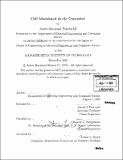Cell modulated DC/DC converter
Author(s)
Warren, James Raymond, III
DownloadFull printable version (4.209Mb)
Alternative title
Cell modulated direct current/direct current converter
Other Contributors
Massachusetts Institute of Technology. Dept. of Electrical Engineering and Computer Science.
Advisor
David J. Perreault and Timothy C. Neugebauer.
Terms of use
Metadata
Show full item recordAbstract
A very high frequency converter roughly based on a class E topology is investigated for replacing a conventional boost converter circuit. The loss mechanisms in class E inverters are characterized, and metrics are developed to aid in device selection for high frequency converter. A (30 MHz) converter is developed based on a modified class E inverter, single diode rectifier, and cell modulation control architecture based on the Fairchild Semiconductor FDN361AN MOSFET identified by the device selection metrics. In addition to meeting the output specification of 1 W to 2 W, the converter has the ability to deliver up to 3W over its entire input voltage range of 3.6V to 7.2V. Converter efficiencies were realized ranging from from 71% to 81%. Finally, converter transient response to a 2:1 load step did not even exceed the transient ripple of the converter, approximately 100mV. Higher frequency design allowed for decreasing the magnitude of passive values, and in turn their corresponding physical size. Smaller magnitude components reduced the energy storage in the circuit, allowing for the improved transient response. (cont.) A potential application for this research include integration of the circuit and/or passive components for further miniaturization. Potential applications that could take advantage of the significantly improved transient response are circuits facing load transients, or applications designed to actively modulate their supply voltage or power.
Description
Thesis (M. Eng.)--Massachusetts Institute of Technology, Dept. of Electrical Engineering and Computer Science, 2005. Includes bibliographical references (p. 97-99).
Date issued
2005Department
Massachusetts Institute of Technology. Department of Electrical Engineering and Computer SciencePublisher
Massachusetts Institute of Technology
Keywords
Electrical Engineering and Computer Science.